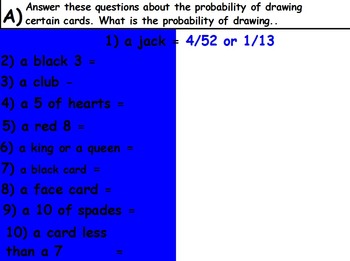Probability - Deck of Cards Part 1 (SMART BOARD)
Engaging Einsteins
426 Followers
Grade Levels
6th - 8th, Homeschool
Subjects
Resource Type
Standards
CCSS7.SP.C.6
CCSS7.SP.C.7
CCSS7.SP.C.7a
CCSS7.SP.C.7b
CCSS7.SP.C.8
Formats Included
- Flipchart File
Pages
8 pages
Engaging Einsteins
426 Followers
Description
This lesson introduces the concept of probability using a deck of cards. It covers the basics of finding probability and includes a pre-class question to assess prior knowledge. Compliant with state standards and objectives, it is designed to engage and maintain the interest of all students with its colorful diagrams and detailed information. The included worksheet pack ensures that all students remain involved in the lesson, even while one student works directly with the teacher.
Total Pages
8 pages
Answer Key
N/A
Teaching Duration
2 days
Report this resource to TPT
Reported resources will be reviewed by our team. Report this resource to let us know if this resource violates TPT’s content guidelines.
Standards
to see state-specific standards (only available in the US).
CCSS7.SP.C.6
Approximate the probability of a chance event by collecting data on the chance process that produces it and observing its long-run relative frequency, and predict the approximate relative frequency given the probability. For example, when rolling a number cube 600 times, predict that a 3 or 6 would be rolled roughly 200 times, but probably not exactly 200 times.
CCSS7.SP.C.7
Develop a probability model and use it to find probabilities of events. Compare probabilities from a model to observed frequencies; if the agreement is not good, explain possible sources of the discrepancy.
CCSS7.SP.C.7a
Develop a uniform probability model by assigning equal probability to all outcomes, and use the model to determine probabilities of events. For example, if a student is selected at random from a class, find the probability that Jane will be selected and the probability that a girl will be selected.
CCSS7.SP.C.7b
Develop a probability model (which may not be uniform) by observing frequencies in data generated from a chance process. For example, find the approximate probability that a spinning penny will land heads up or that a tossed paper cup will land open-end down. Do the outcomes for the spinning penny appear to be equally likely based on the observed frequencies?
CCSS7.SP.C.8
Find probabilities of compound events using organized lists, tables, tree diagrams, and simulation.




